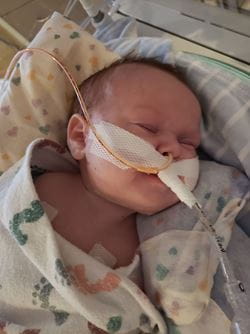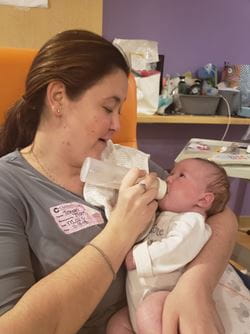Emily Troyan was 20 weeks pregnant when an ultrasound showed her unborn son likely had Pierre Robin sequence (PRS), a rare congenital condition involving an underdeveloped jaw and cleft palate. Because of his tiny jaw, his tongue would block his airway, making it nearly impossible for him to breathe after he was born.
Unlike most expectant mothers, Emily was already familiar with PRS — a condition she was diagnosed with at birth in 1985. She and her husband, Alan, were referred to specialists at UPMC Children’s Hospital of Pittsburgh and UPMC Magee-Womens Hospital, who began making plans for Noah’s arrival.
Advanced Planning
Ironically, it was Sept. 5, 2018 — Pierre Robin Sequence Awareness Day — when the Troyans first went to UPMC Children’s Hospital for an appointment with specialists at the Cleft-Craniofacial Center.
 There, they met with center director Jesse Goldstein, MD, a craniofacial plastic surgeon, and Matt Ford, MS, CCC-SLP, clinical coordinator and speech pathologist. They also met with Allison Tobey, MD, a pediatric otolaryngologist.
There, they met with center director Jesse Goldstein, MD, a craniofacial plastic surgeon, and Matt Ford, MS, CCC-SLP, clinical coordinator and speech pathologist. They also met with Allison Tobey, MD, a pediatric otolaryngologist.
The specialists recommended a rare procedure called ex-utero intrapartum treatment (EXIT) to allow doctors to establish an airway for Noah as he was being born. It would require careful coordination with Emily’s maternal fetal medicine specialist Stephen Emery, MD, director of the Center for Innovative Fetal Intervention at UPMC Magee-Womens Hospital. Dr. Tobey, co-director of the EXIT Simulation Program at UPMC Children’s, would be in the delivery room to assist in the intubation procedure.
“They didn’t want Noah to be without oxygen. Because his airway could be blocked, they wanted to intubate him before he’d lose his oxygen supply,” says Emily.
“It required a lot of planning between Children’s and Magee. Once we met the doctors, it put us at ease knowing we had a good support team behind us,” says Alan.
Special Delivery
On Oct. 2, 2018, a multidisciplinary team of 30-plus surgeons, nurses, anesthesiologists, and neonatal specialists were in the Magee operating room when Emily was placed under anesthesia for the specialized Cesarean section. After Noah’s head and right arm had emerged, delivery was paused while an IV line was inserted. He was still connected to Emily’s placenta and receiving blood and oxygen when doctors intubated Noah through his nose.
The 6-pound, 8-ounce newborn spent 30 minutes with his parents before he was transferred by ambulance to the neonatal intensive care unit (NICU) at Children’s.
“It was amazing having this team ready and waiting. Noah was born in exactly the right place for the care he needed,” says Emily
Jaw Distraction Surgery
When Emily was born in the 1980s, there weren’t as many options available to treat her birth defects. She initially needed a feeding tube and breathed through a tracheostomy tube inserted through her windpipe until she was a year old. She had palate repair surgery and a tongue-lip adhesion procedure to keep her tongue out of her airway, but doctors decided to allow her jaw to grow out on its own.
“I heard lots of teasing growing up about how I looked. It was hard for me to think about Noah going through the same thing,” says Emily.
Emily was relieved to learn her newborn could avoid some of these issues by having jaw distraction surgery — the current “gold standard” for treating infants with a recessed chin (called micrognathia). The procedure opens the airway by gradually lengthening the jaw, so intubation is no longer necessary.
When Noah was 17 days old, Dr. Goldstein separated his jaw on each side and inserted distractors (a device to lengthen the bone). Twice a day over the next two weeks, the device was turned until Noah’s jaw had been extended by 20 mm.
Within 10 days, Noah’s jaw had lengthened enough for him to be extubated. Noah failed a swallow test at the 14-day mark, so they decided to extend his jaw another 5 mm by turning the device once a day for one more week.
“The change was dramatic,” says Emily. “Noah went from having no chin to having a regular jaw.”
Noah passed a second swallow test when he was seven weeks old. A week later, the Troyans were finally able to take their baby to their Butler County home — without a feeding tube or tracheostomy.
A Multidisciplinary Team
Three months after his surgery, Noah returned to Children’s to have the distractors removed by Dr. Goldstein. While he was under anesthesia, Dr. Tobey inserted ear tubes to help with drainage and prevent ear infections — a problem frequently experienced by children with PRS.
 When Noah was 12 months old, Dr. Goldstein repaired his cleft palate and the ear tubes were reinserted. At 19 months, Dr. Tobey removed Noah’s tonsils and part of his adenoids to make more space for breathing and eating. She again reinserted ear tubes. Like many children with PRS, Noah also has dental issues and is seen regularly by a pediatric dentist. He will have dental surgery in September to remove two teeth and cap six to eight cavities.
When Noah was 12 months old, Dr. Goldstein repaired his cleft palate and the ear tubes were reinserted. At 19 months, Dr. Tobey removed Noah’s tonsils and part of his adenoids to make more space for breathing and eating. She again reinserted ear tubes. Like many children with PRS, Noah also has dental issues and is seen regularly by a pediatric dentist. He will have dental surgery in September to remove two teeth and cap six to eight cavities.
Genetic testing done when Noah was six months old revealed he also has Stickler syndrome — a connective tissue disorder likely inherited from his mother. It affects collagen throughout the body and can lead to joint problems, eye abnormalities, and hearing loss.
“Noah has loose, bendy joints,” says Emily. “He also has some nearsightedness and is at risk for retinal detachment and hearing issues.”
Because PRS and Stickler syndrome are complicated medical conditions, Noah continues to receive care from the multidisciplinary team of experts at Children’s.
Once a year, Noah returns to the Cleft-Craniofacial Center to see Dr. Goldstein and Matt Ford. He also sees Dr. Tobey and a speech therapist and has yearly hearing tests. A pediatric ophthalmologist examines Noah’s eyes every six months. He also sees a neurologist and cardiologist.
“That’s one of the things I love about the Children’s team. They are so thorough,” says Emily. “They want to make sure your child sees the specialists they need to see.”
The Troyans are grateful that team appointments are scheduled to ensure Noah sees all his specialists in one visit. That’s makes it easier for the family, who drives 45 minutes to get to Children’s.
“Having team appointments makes life so much easier,” says Emily. “And the communication has been fantastic. Everyone on the team always knows what’s going on. We don’t have to keep repeating Noah’s history every time we see someone.”
Hitting Milestones
Despite his rough start, Noah quickly made up for lost time. While he was slow to roll over, he did it around six months, was crawling by eight months, and walking by 11 months.
He initially needed occupational therapy to help with swallowing and later had speech therapy. Although he first used baby sign language to communicate, he was talking by 30 months and “hasn’t stopped talking since!” say his parents.
When Noah tested out of speech therapy at age three, the tester commented that she’d never met a three-year-old who talked so much.
“He’s talkative, full of energy, plays soccer, and loves power wheels, playgrounds, swing sets, mud, and dirt,” says Alan. “He’s turned out to be a very normal, happy-go-lucky kid.”
“He’s also extremely social and one of the sweetest kids you’ll ever meet. He’s always trying to give away his toys to people,” says Emily.
The Troyans expressed their gratitude for Dr. Goldstein and the entire cleft-craniofacial team.
“We couldn’t have done this without the whole team at Children’s Hospital,” says Alan. “They are true miracle workers, and we can’t thank them enough. We feel blessed to have them in our backyard.”
“They gave us our son, they gave us his life,” says Emily. “There aren’t enough words to express our gratitude.”
Plastic Surgery Resources
Read more about plastic surgery resources from UPMC Children's Hospital Department of Plastic Surgery.









